
The New Zealand mud snail is a species of very small freshwater snail with a gill and an operculum. This aquatic gastropod mollusk is in the family Tateidae.

Intertidal ecology is the study of intertidal ecosystems, where organisms live between the low and high tide lines. At low tide, the intertidal is exposed whereas at high tide, the intertidal is underwater. Intertidal ecologists therefore study the interactions between intertidal organisms and their environment, as well as between different species of intertidal organisms within a particular intertidal community. The most important environmental and species interactions may vary based on the type of intertidal community being studied, the broadest of classifications being based on substrates—rocky shore and soft bottom communities.

Rapana venosa, common name the veined rapa whelk or Asian rapa whelk, is a species of large predatory sea snail, a marine gastropod mollusc or whelk, in the family Muricidae, the rock shells.

Zeacumantus is a genus of small to medium-sized sea snails or mud snails, marine gastropod mollusks in the family Batillariidae.

Zeacumantus subcarinatus, common name the southern creeper, is a species of small sea snail or mud snail, a marine gastropod mollusc in the family Batillariidae.
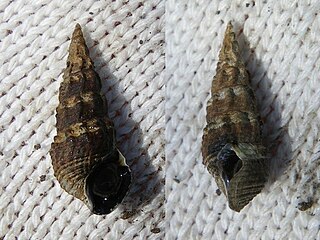
Batillaria is a genus of small salt marsh or mudflat snails, marine gastropod mollusks in the family Batillariidae, the horn snails.
Beddomeia camensis is a species of very small freshwater snail that is endemic to Australia. The invertebrate is 2-4 mm in size, it is a gastropod mollusk and belongs to the Hydrobiidae family, a large family of freshwater snails recognised by their small size and cosmopolitan distribution. Beddomeia camensis is one of the least populated species within its family distributed across only 5 small to medium-sized streams that flow into the Cam River catchment in North-West Tasmania.

Bradybaena similaris, the Asian trampsnail, is a species of small, invasive land snail. It is a pulmonate gastropod terrestrial mollusc in the family Bradybaenidae. It earned the common name based on its origins, and its habit of roosting on freight containers. This habit means that this may be one of the most broadly-distributed species of terrestrial snail in the world. Bradybaena similaris is the type species of the genus Bradybaena.

Pomacea canaliculata, commonly known as the golden apple snail or the channeled apple snail, is a species of large freshwater snail with gills and an operculum, an aquatic gastropod mollusc in the family Ampullariidae, the apple snails. South American in origin, this species is considered to be in the top 100 of the "World's Worst Invasive Alien Species". It is also ranked as the 40th worst alien species in Europe and the worst alien species of gastropod in Europe.
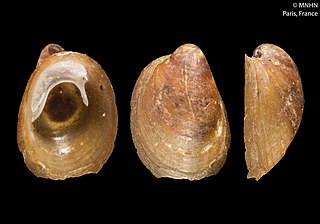
Crepidula, commonly known as the slipper snails, slipper limpets, or slipper shells, is a genus of sea snails, marine gastropod mollusks in the family Calyptraeidae. This family includes the slipper snails (Crepidula), hat snails (Calyptraea), spiny slipper snails (Bostrycapulus), and cup-and-saucer snails (Crucibulum) as well as Crepipatella, Siphopatella, Grandicrepidula, and Maoricrypta.
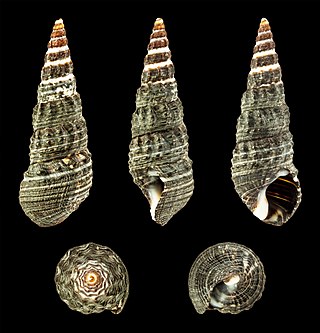
Batillaria zonalis is a species of small sandy shore snail, a marine gastropod mollusk in the family Batillariidae, the horn snails.
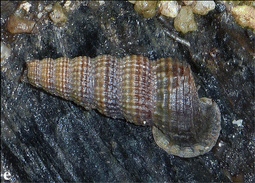
Cerithidea is a genus of medium-sized sea snails or mud snails, marine gastropod mollusks in the family Potamididae, the horn snails.

Pteropurpura festiva, commonly known as the festive murex, is a species of predatory sea snail, a marine gastropod mollusk in the family Muricidae, the rock snails. Native to the Eastern Pacific, these sea snails grow to 34–67 mm in length.

Aristofusus excavatus, common name apricot spindle, is a species of sea snail, a marine gastropod mollusk in the family Fasciolariidae, the spindle snails, the tulip snails and their allies.

Cerithium caeruleum, the Cerith sand snail, is a species of sea snail, a marine gastropod mollusk in the family Cerithiidae. Cerithium caeruleum, also be called Cerithium caeruleum G.B. Sowerby II, 1855 generally can be found in large populations on intertidal rocky shores and are covered by a thin layer of sediments. They have large and solid shells, and their radula ribbon robust long about one-fifth the shell length. This species lives in the planktonic stage from 90 to 120 days and has a seven-year life history. This common intertidal species is confined to east Africa, Madagascar, and the Arabian Peninsula and is unlikely to be confused with any other Cerithium species. It is distinguished by its squat, knobby shape; and as indicated by its name, caeruleum, a grayish blue color with spiral rows of black tubercles.

Cerithideopsis californica, common name the California hornsnail or the California horn snail, is a species of sea snail, a marine gastropod mollusk in the family Potamididae. This series was previously known as Cerithidea californica.
Spurwinkia salsa is a species of very small aquatic snail, an operculate gastropod mollusk in the family Cochliopidae.
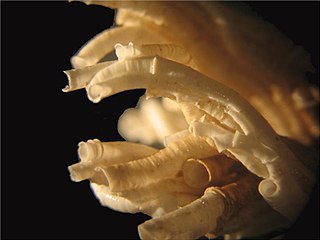
Ficopomatus enigmaticus, commonly known as the Australian tubeworm, is a species of serpulid tubeworms. Their true native range is unknown, but they probably originated in the Southern Hemisphere, perhaps from the Indian Ocean and the coastal waters of Australia. Today they have a cosmopolitan distribution, having been introduced to shallow waters worldwide. The Australian tubeworm is an invasive species that dominates and alters habitats, reduces water quality, depletes resources, and causes biofouling.
Cerithideopsis is a genus of medium-sized sea snails or mud snails, marine gastropod mollusks in the family Potamididae, the horn snails.
















